中国组织工程研究 ›› 2016, Vol. 20 ›› Issue (52): 7829-7835.doi: 10.3969/j.issn.2095-4344.2016.52.011
• 材料生物相容性 material biocompatibility • 上一篇 下一篇
磷酸钙骨水泥/纤维蛋白胶复合材料填充桡骨缺损的生物相容性
黄 田1,郑南生2,张育专1,吴永乐1,王 刚1
- 1海南省第二人民医院,海南省五指山市 572299;2海南省中医院,海南省海口市 570203
Biocompatibility of calcium phosphate cement/fibrin glue in filling radius defects
Huang Tian1, Zheng Nan-sheng2, Zhang Yu-zhuan1, Wu Yong-le1, Wang Gang1
- 1Second People’s Hospital of Hainan Province, Wuzhishan 572299, Hainan Province, China; 2Hainan Provincial Hospital of Chinese Medicine, Haikou 570203, Hainan Province, China
摘要:
文章快速阅读:
.jpg)
文题释义:
磷酸钙骨水泥:是一种可降解生物材料,由一种或几种磷酸钙盐固体与液体混合而成。磷酸钙骨水泥材料具有许多的生物学优点,主要有生物降解性、骨引导活性、一定的抗压强度,是临床上较好的骨替代材料。但是,磷酸钙降解速度较慢,自身有一定脆性,显著限制了其在临床中的应用。
纤维蛋白凝胶:主要由天然细胞外基质成分构成,具有良好的生物相容性、有效的生物活性及生物可降解性,同时还具有三维多孔结构和良好的可塑性。研究发现纤维蛋白凝胶在体内的代谢过程可产生多种细胞因子,促进骨组织再生。
背景:磷酸钙骨水泥与人体自身骨矿物的化学组成和结构相似,能够填充因骨折造成的骨质塌陷,具有诱导成骨作用,但其降解速度较慢。
目的:评估磷酸钙骨水泥/纤维蛋白胶复合材料的生物相容性及修复桡骨缺损的可行性。
方法:①体外细胞毒性实验:分别以磷酸钙骨水泥/纤维蛋白胶材料浸提液、苯酚溶液,含体积分数为10%胎牛血清RPMI1640培养液培养小鼠成纤维细胞,检测细胞毒性分级;②血液相容性实验:在兔抗凝血中分别加入磷酸钙骨水泥/纤维蛋白胶材料浸提液、生理盐水及双蒸水,检测溶血率;③取45只新西兰大白兔,制备双侧桡骨缺损模型,随机分3组,空白对照组不进行任何干预,实验组与骨缺损处植入磷酸钙骨水泥/纤维蛋白胶复合材料,对照组植入自体桡骨。术后4,8,16周,进行X射线、组织学、骨密度及生物力学检测。
结果与结论:①细胞毒性:磷酸钙骨水泥/纤维蛋白胶材料浸提液的毒性为0至1级;②血液相容性:磷酸钙骨水泥/纤维蛋白胶材料的溶血率为3.15%;③体内修复实验:术后16周,X射线显示,实验组和对照组骨折线完全消失,髓腔复通,塑性完全;组织学显示,对照组骨小梁重建较明显,板层骨较成熟,髓腔再通,实验组有大量新生编织骨成网格状长入材料中,材料降解明显,降解与骨长入同步;实验组与对照组骨密度、最大负荷、最大应力和破坏能量均明显高于空白对照组(P < 0.05),实验组与对照组各指标比较差异无显著性意义;④结果表明:磷酸钙骨水泥/纤维蛋白胶复合材料具有良好的生物相容性,修复骨缺损可促进骨组织再生,获得与自体骨移植基本相当的治疗效果。
中图分类号:


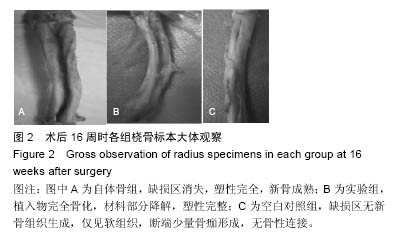
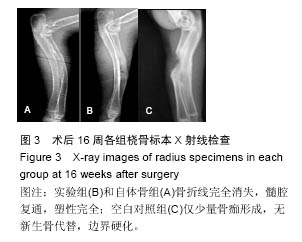
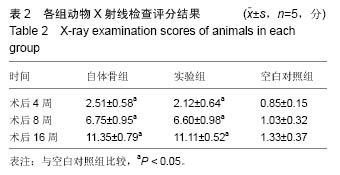
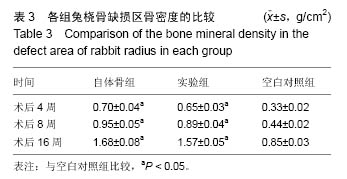

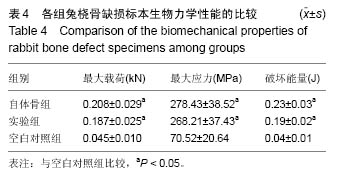
.jpg)